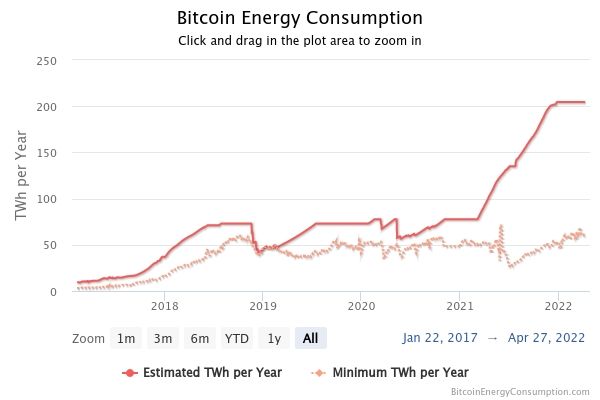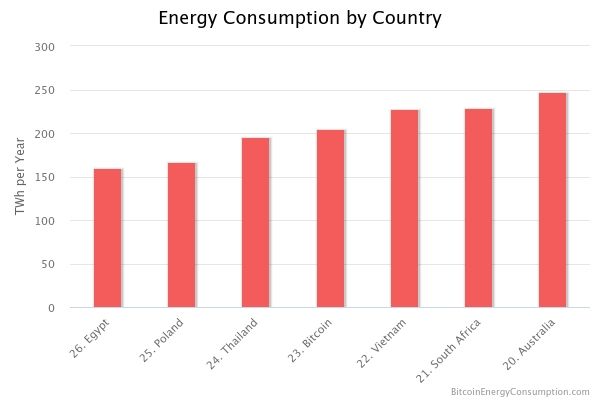The Sustainability of Bitcoin and its Impact on the Environment

When it comes to cryptocurrencies, anyone with the right hardware and software can become miners. Consequently, the ease of availability has generated a new economy centered around digital currencies that have the ability to disrupt any financial system. They are gaining traction all over the world and more people are choosing to invest and take advantage of this new decentralized system. Currently, 86% of Americans report being familiar with cryptocurrencies while 16% have reported having invested, traded, or used any of the digital currency [1]. A similar survey conducted in 2015 which focused exclusively on Bitcoin reported that only 48% of adults claimed that they have heard of Bitcoin while 1% claimed to have ever collected, traded, or used it [1]. Today more people are willing to invest in this new economy and with this new appeal brings a multitude of benefits but also reveals undesirable consequences. Certain cryptocurrencies, such as Bitcoin, hold the potential to become the future of our payment systems and bring forth many advantages such as fast and secure transactions while maintaining transparency as all transactions are public and visible. However, if used long term, Bitcoin has the power to harm the environment.
Some cryptocurrencies are unsustainable–from the mining to the transactional use–and demand a substantial amount of energy which then increases the carbon footprint of cryptocurrencies as a whole. Though cryptocurrencies seem to be the future of our finances, there are concerns about the sustainability aspect, Bitcoin in particular, as its impact on the environment detrimentally affects and contributes to global warming through its high energy requirement.
What is Cryptocurrency and how does it work?
Cryptocurrency is a form of digital currency and is used as an alternative form of payment created using encryption algorithms [2]. Many different types of cryptocurrencies exist–with the most recognizable being Bitcoin, Ethereum, and Ripple. This digital economy first gained traction with the introduction of Bitcoin which was created in 2009 by the pseudonymous software engineer Satoshi Nakamoto [3]. Today more than 2,500 different cryptocurrencies have been created since and follow the same footsteps that Bitcoin pioneered [11].
Cryptocurrencies are mined by validating transactions on the network, which requires miners to solve mathematical problems using consensus mechanisms such as “Proof of Work” or the “Proof of Stake” to guess and check solutions [3]. Those who find the solutions to these complex mathematical problems are rewarded with a “block” of cryptocurrency which then becomes registered and verified on a decentralized database system known as the blockchain [4]. This blockchain then records every single transaction that has taken place with all of the necessary corresponding information and allows for a transparent logging system [5].
There is also a difference in energy usage between the two consensus mechanisms as Proof of Work is original and was first used by Bitcoin. For Proof of Work, a substantial amount of energy is essential in order to meet the processing power that the network requires and is linked to a large carbon footprint [6]. Competition emerges from this environment as miners race against one another to solve these mathematical problems first to be rewarded. This often results in miners attempting to use more energy than their rivals to outpower one another, contributing to the unsustainable nature [6]. Proof of Stake, on the other hand, focuses on “staking” instead of mining and leaves out the competitive nature of Proof of Work by introducing a system similar to a lottery. Ethereum is currently attempting to integrate Proof of Stake and estimates that the merge could result in a 99.95% reduction in total energy use and overall be more energy efficient when compared to Proof of Work [6].
Since Proof of Work was the pioneer for mining when Bitcoin was discovered, the issue of its high energy usage was not a large concern. The cryptocurrencies that followed shortly after innovated and transferred from the use of Proof of Work to Proof of Stake to reduce the computational and environmental strain. Though many cryptocurrencies are conscious of the environmental pressure and work to lessen the burden through demonstrating a commitment to change their mining styles, Bitcoin has not shown any signs of following suit and continues to use Proof of Work. It is highly unlikely that Bitcoin will switch to using the Proof of Stake model as Proof of Work is integral for Bitcoin miners.
Bitcoin’s Environmental Impact and Why it Matters
Bitcoin is arguably the biggest perpetrator in terms of environmental impact as it has proven to be the most lucrative. This is due to the fact that Bitcoin is unregulated and no policies exist to stop miners from prioritizing profit over the issue of environmental sustainability. Miners will often go out of their way to source the cheapest electricity possible and use it in large quantities in an effort to gain the highest net profit. Thus, there is an incentive to mine and outsource one another, creating a feedback loop where miners are always on the lookout to outpower one another with more electricity in hopes of gaining the Bitcoin rewards first. This motivation contributes towards Bitcoin's large carbon footprint which accelerates climate change. A study which looked into the economic perspective of Bitcoin’s environmental impact found that “each 1 USD of Bitcoin created was responsible for 0.49 USD in health and climate damages in the United States” [11]. This study gives tangible evidence of the effects of cryptocurrency mining and places a price on the consequences, giving a sense of urgency to the magnitude of this problem.

In 2018, Bitcoin was estimated to use at least 40.0 TWh, or possibly up to 62.3 TWh of electrical energy over the full year of 2018 [8]. The amount of energy used is comparable to the amount of electricity consumed by countries like Hungary, which used 40.3 TWh, or even Switzerland, which used 62.1 TWh that same year [8]. As of today, Bitcoin is estimated to have used 144.16 TWh, which is a significant increase over the span of four years [9]. Thus, Bitcoin is responsible for the highest amount of energy consumption and another study that focused on the possible future environmental impacts of Bitcoin estimated that Bitcoin alone has the potential to contribute towards global warming and increase the temperature of the Earth by two degrees by its carbon dioxide emissions [10].
The energy consumption of Bitcoin should be paid attention to as it produces an ethical dilemma: it is not equitable for Bitcoin miners to exploit a public good for private gain as the environment suffers the consequences.

Eco-friendly Initiatives of Companies/Organizations
After speaking with multiple organizations that are making efforts to make cryptocurrencies more sustainable, there are new forms and technologies that are constantly innovating to further sustainability for this digital economy.
Chia, created by Bram Cohen, aims to deliver critical security and compliance to enable safer and easier transactions[12]. Instead of utilizing the Proof of Stake model, Chia Coin created the innovative Proof of Space and Time Consensus to minimize their energy consumption. As a result, Chia uses 0.16% of the annual energy consumption of Bitcoin and 0.36% of Ethereum in an effort to become more sustainable[12]. With his creation of the Proof of Space and Time Consensus, Chia is able to remove the energy demands of Proof of Work from the system in addition to having significantly better security due to its more decentralized blockchain” [12]. In its essence, Chia offers an improved version of the Proof of Work system that Bitcoin uses, while using less energy without compromising security.
Colin LeMahieu observed the sustainability issues with Bitcoin and created Nano after experimenting with different solutions other than turning directly to Proof of Stake or other existing solutions. What makes Nano unique is how it performs as a cryptocurrency without the need for mining[13]. LeMahieu emphasized Nano’s “laser sharp focus on being the most efficient energy” and introduced Open Representative Voting–Nano’s ethical version of Proof of Work. This mechanism allows Nano to use less energy where the “energy consumption of the network is less than the production of a single wind turbine.”
Bitgreen, another cryptocurrency focused on sustainability, also revolutionized the mining process, straying from the Proof of Work model and utilizing the Proof of Stake consensus model [14]. The founder, Adam Carver, understands that the Earth is near the “point of no return” when it comes to climate change and hopes to use Bitgreen in order to lead towards a more equitable future for all[14]. To achieve this, Bitgreen uses Proof of Stake which uses 99.5% less electricity to operate their network when compared to Proof of Work. Carver also emphasized the fundamental activities of the chain and how their applications are specifically geared towards raising money for impact and sustainable initiatives such as investing toward renewable energy and recycling programs. It is not enough to remain carbon neutral, but rather many should put in tangible effort to move away from neutrality. As a result, there should be a focal point around making a positive impact instead and taking strides to improve the situation–this ultimately is what sustainability means for Bitgreen.
These founders acknowledge the unsustainable nature of cryptocurrencies and have found solutions that center around the issue of sustainability without compromising the key aspects of cryptocurrencies such as fast and secure transactions. This in turn, demonstrates that it is possible for cryptocurrencies to be sustainability is taken into consideration.
Overall Solutions
There are a multitude of benefits cryptocurrencies bring and the future it holds to advance and innovate the digital economy. This is a sector that brings many opportunities and has the capability to bring accessibility to the general public. Though the very nature of certain cryptocurrencies are unsustainable, changing the mining practices of those who utilize Proof of Work and using recent innovations, focusing especially on Bitcoin, will cultivate the future for cryptocurrencies.
As a relatively new world, cryptocurrencies are always evolving and innovating different aspects whether it be the mining process or even the systems that are used. The issue regarding the sustainability of cryptocurrencies do not go unnoticed and many are taking steps towards ensuring their future as many of the eco-cryptocurrencies have shown. The main concern lies with cryptocurrencies that continue to use Proof of Work despite knowing its harmful impact on the environment. Bitcoin is a reputable cryptocurrency with many miners and users and currently has no visible plans on changing their mining practices from Proof of Work to Proof of Stake unlike Ethereum.
Ethereum recently demonstrated a transition from Proof of Work to Proof of Stake and the new Ethereum 2.0 with a full transition to Proof of Stake is projected to launch in the near future. Bitcoin is the largest cryptocurrency with Ethereum being the second largest. Thus, if the merge to Proof of Stake is successfully launched, Ethereum provides a blueprint that Bitcoin could follow in order to be more sustainable. Like Bitcoin, Ethereum started with Proof of Work and recently made upgrades and changes to implement Proof of Stake in an effort to be more environmentally conscious. This transition–though it was extensive as it took around six years and only recently successfully merged on March 15, 2022–presents a situation that demonstrates how the transition from Proof of Work to Proof of Stake is indeed possible and could feasibly be applied to Bitcoin. Despite the large time commitment, the payoff for Ethereum is projected to be extremely profitable and is expected to take dominance over the Bitcoin blockchain and will become the most lucrative since it takes into concern the issues regarding sustainability, making Ethereum a better investment for the long term. As mentioned before, the merge to Proof of Stake allows Ethereum to reduce energy consumption by 99.95% and will remain as lucrative, if not more now than ever since Ethereum has secured their place in the future with this transition.
The transition illustrated that there were no compromises in the worth and security of Ethereum and ultimately showed that there are ways Bitcoin can learn from this transition to become more sustainable. In addition, considering how both Bitcoin and Ethereum began with the Proof of Work consensus mechanism while also keeping in mind that they are the largest and second largest cryptocurrency as of right now goes to show that it is feasible for Bitcoin to make the transition to Proof of Stake, similar to Ethereum. However, there are concerns in the Bitcoin community about changing to the Proof of Stake mechanism since Bitcoin miners believe Proof of Work to be central to Bitcoin as it is a key aspect that largely contributed to its success from the beginning. Bitcoin miners have invested their time and money into the mining equipment–switching to Proof of Stake would prove their investments as a waste. In addition, Bitcoin was created by an enigma, Satoshi Nakamoto. There is no central figurehead for the Bitcoin community which makes it more difficult for the Bitcoin community to collectively decide to move toward the Proof of Stake system. However, the longevity of Bitcoin will be short lived if this community continues on this path without concern for its impact on the environment. Supporters of Bitcoin and miners should shy away from short term gratifications and should focus on improving Bitcoin by changing the consensus mechanism to Proof of Stake. Just as all cryptocurrencies that came after Bitcoin had the luxury of learning from what Bitcoin created, Bitcoin is now able to learn from those who are turning to Proof of Stake in order to become sustainable.
Sources
- https://www.pewresearch.org/fact-tank/2021/11/11/16-of-americans-say-they-have-ever-invested-in-traded-or-used-cryptocurrency/
- https://www.oswego.edu/cts/basics-about-cryptocurrency
- https://dl.acm.org/doi/abs/10.1145/3205230.3205233
- https://www.npr.org/sections/parallels/2018/04/23/597780405/how-the-tiny-nation-of-georgia-became-a-bitcoin-behemoth
- https://link.springer.com/content/pdf/10.1007/s12599-017-0467-3.pdf
- https://www.coinbase.com/learn/crypto-basics/what-is-proof-of-work-or-proof-of-stake
- https://digiconomist.net/bitcoin-energy-consumption
- https://www.cell.com/joule/fulltext/S2542-4351(19)30087-X
- https://ccaf.io/cbeci/index
- https://news.climate.columbia.edu/2021/09/20/bitcoins-impacts-on-climate-and-the-environment/
- https://www.sciencedirect.com/science/article/pii/S2214629619302701
- https://www.chia.net
- https://nano.org
- https://bitgreen.org



